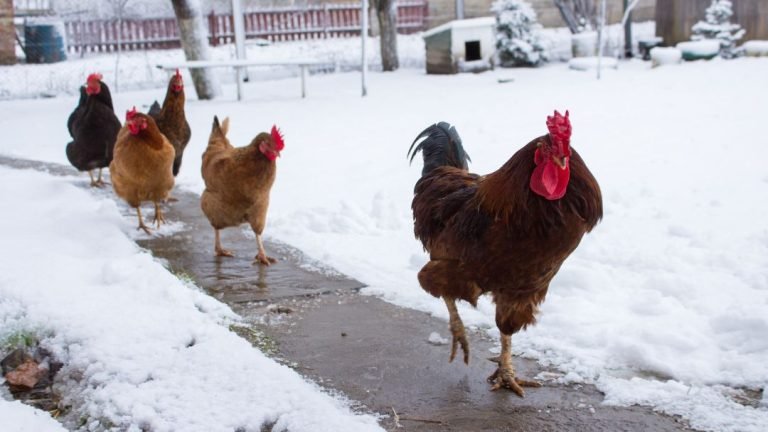Introducing new chickens to your flock should be done slowly and cautiously. We will discuss the steps you should take to ensure a smooth integration process for your new feathered friends.
Whether you are expanding your flock or introducing a few new members, it is important to consider factors such as space, quarantine, and social dynamics. By following these guidelines, you can minimize stress and potential conflicts among your chickens, allowing them to establish a harmonious pecking order and thrive in their new environment.
So, let’s dive in and learn the best practices for introducing new chickens to your flock.
Preparing For Introduction
Introducing new chickens to your flock can be a delicate process. Careful preparation is essential to ensure a smooth transition and minimize stress for both the existing and new birds. Follow these steps to ensure a successful introduction.
Choosing The Right Time To Introduce New Chickens
- Spring and early summer months are the ideal time to introduce new chickens to your flock.
- Avoid introducing new chickens during extreme weather to reduce stress on both new and existing flock members.
- Choose a time when you can closely monitor the flock to ensure the introduction goes smoothly.
Assessing The Health And Safety Of Your Existing Flock
- Before introducing new chickens, assess the health and safety of your existing flock to prevent the spread of diseases and minimize aggression.
- Observe your current chickens for signs of illness or injury, such as sneezing, coughing, or limping.
- Quarantine any sick or injured chickens and consult a veterinarian if needed.
- Make sure your current flock is up to date on vaccinations and deworming.
Creating A Separate Space For New Chickens
- Provide a separate space for the new chickens to prevent direct contact with the existing flock initially.
- Use a chicken wire fence or a separate coop/run to keep the new chickens safe and separate from the existing flock.
- Ensure the new chickens have enough space to move around, access food and water, and take shelter.
- Separate feeding and watering areas can help reduce competition and aggression during the introduction phase.
By following these steps, you can prepare for introducing new chickens to your flock in a way that minimizes stress, promotes a healthy environment, and increases the chances of a successful integration. Remember, taking the time to plan and prepare beforehand can greatly benefit the overall well-being of your chickens.

Introducing New Chickens: Key Steps
Introducing new chickens to your flock requires careful steps. Follow these crucial guidelines for a smooth integration process.
Initial Visual Introduction
When adding new chickens to your existing flock, the first step is to introduce them visually. This will allow the birds to get accustomed to each other’s presence without direct contact. Here are some key steps to follow:
- Start by placing the new chickens in a separate enclosure within the existing coop or run.
- Ensure that the enclosure has wire mesh or fencing that allows the birds to see each other while maintaining physical separation.
- Allow the chickens to spend a few days observing each other from a distance. This will help them become familiar with each other’s appearances and behaviors.
- During this initial phase, monitor their reactions and body language to gauge their comfort levels.
- Note any signs of aggression or excessive stress, such as raised feathers or loud vocalizations, as these may indicate a need for further adjustment.
Supervised Interaction In A Neutral Territory
Once the chickens have become accustomed to each other visually, the next step is to introduce them to a neutral territory. This can help minimize territorial disputes and establish a new pecking order. Follow these steps to ensure a smooth transition:
- Select a neutral, fenced-off area that is unfamiliar to both the new chickens and the existing flock. This can be a separate section of the coop or an enclosed space outside.
- Monitor the birds closely during the introductions to prevent any aggressive behavior.
- It’s best to introduce new chickens in small groups, rather than all at once, to avoid overwhelming the existing flock.
- Allow the chickens to interact under supervision for short periods, gradually increasing the duration over time.
- Watch for any signs of aggression or bullying, such as excessive pecking or chasing. If necessary, separate any overly aggressive individuals to maintain harmony within the flock.
Monitoring Body Language And Behavior
Observing the body language and behavior of your chickens during the introduction process is crucial in ensuring their well-being. Here are some important things to keep in mind:
- Pay attention to the general demeanor of the birds. Relaxed and calm behavior indicates that they are adapting well to the new additions.
- Keep an eye on their pecking order dynamics. It’s normal for chickens to establish a hierarchy, but excessive aggression should be addressed promptly.
- Look for signs of stress or distress, such as feather picking or anxious pacing. These may indicate that the new chickens are struggling to integrate.
- Provide ample food and water sources to prevent competition and reduce potential conflicts.
- Remember that introductions can take time, and each flock is unique. Patience and careful monitoring are key to ensuring a successful integration.
By following these key steps – the initial visual introduction, supervised interaction in neutral territory, and monitoring body language and behavior – you can help ensure a smooth and healthy integration of new chickens into your existing flock. Remember to be patient and attentive, allowing the chickens to dictate the pace of their socialization.
With time, they will establish their pecking order and form a cohesive flock.
Gradual Integration And Socialization
Gradually integrate and socialize new chickens by introducing them to your existing flock. This process ensures a smooth transition and fosters harmonious relationships within the group.
Progressively Increasing The Time Spent Together
Integrating new chickens into an existing flock can be a delicate process that requires careful planning and consideration. Gradual integration and socialization are key to ensuring a smooth transition and minimizing any potential conflicts. By progressively increasing the time spent together, you can facilitate bonding and acceptance among the chickens.
Here are some strategies to help you with this process:
- Separation with Visual Contact: Start by placing the new chickens in a separate but adjacent space, such as a divided coop or wire mesh enclosure. This allows them to see and observe each other, promoting familiarity without physical contact.
- Short Supervised Encounters: Gradually introduce short supervised sessions where the chickens can interact directly. Begin with brief interactions and closely monitor their behavior for signs of aggression or stress.
- Extended Daily Outings: As the chickens become more accustomed to one another, gradually increase the duration and frequency of their interactions. Allowing them to have supervised outings together in a confined area, such as a fenced yard, can help foster positive interactions and reduce hostility.
- Nighttime Coop Integration: Before fully integrating the new chickens into the existing flock, consider placing them in the coop at night when the established chickens are already roosting. This can help facilitate a smoother integration, as chickens are more passive during this time.
Assessing The Dynamics And Managing Aggression
Understanding the dynamics within your flock is crucial for successful integration. It is essential to assess the behavior and hierarchy of the chickens while taking steps to manage any aggression that may arise. Here are some tips to help you in this process:
- Monitor Body Language: Observe the body language of the chickens during their interactions. Signs of aggression may include raised feathers, pecking, chasing, and aggressive vocalizations. Keeping a close eye on these behaviors can help you identify potential issues.
- Separate Aggressive Individuals: If you notice a chicken displaying continuous aggression towards the new members, it may be necessary to temporarily separate them. This will help prevent further harm and give the new chickens a chance to establish themselves within the flock.
- Introduce Distractions: Providing environmental enrichment, such as hanging treats or introducing new objects, can help distract chickens and redirect their focus from aggressive behavior. This can be particularly useful during initial encounters to minimize tension.
- Provide Sufficient Space: Ensure that the chickens have enough room to establish their territories and escape from potential confrontations. Overcrowded spaces can lead to increased aggression, so providing ample space is crucial for maintaining harmony within the flock.
Encouraging Pecking Order Establishment
Establishing a pecking order is a natural process within chicken flocks. It helps maintain a social hierarchy and reduces the chances of aggression. As new chickens are integrated, it is important to foster the development of a stable pecking order. Here are some strategies to encourage this process:
- Provide Multiple Resources: Ensure that there are multiple food and water sources, as well as several places to roost. Having sufficient resources reduces competition among the chickens and minimizes the chances of aggressive behavior.
- Avoid Interference: While it may be tempting to intervene during aggressive encounters, it is best to allow the chickens to establish their own pecking order. Interfering too much can disrupt the natural dynamics and prolong the integration process.
- Don’t Separate Minor Squabbles: Minor squabbles and pecking are normal as chickens establish their social hierarchy. Unless it escalates to excessive aggression or physical harm, it is advisable to let them work it out themselves.
- Ensure Adequate Supervision: Regularly monitor the integration process and intervene only when necessary. This allows you to identify and address any potential issues before they escalate.
Remember, gradual integration and socialization are key to successfully introducing new chickens to your flock. By progressively increasing the time spent together, assessing the dynamics, and encouraging the establishment of a pecking order, you can promote harmony and a smooth transition for your feathered friends.
Supporting The Integration Process
Introducing new chickens to your existing flock can be a delicate and challenging process. The goal is to ensure a smooth integration that minimizes stress and establishes harmony among the feathered members of your coop. To support this integration process, there are a few key factors to consider:
Providing Adequate Space And Resources
- Enough Space: Make sure each chicken has enough room to move and establish their own territory within the coop. This helps prevent overcrowding and territorial disputes.
- Separation: Initially, it’s a good idea to separate the new chickens from the existing flock to avoid aggressive behavior. This can be done by using a temporary partition or separate enclosure within the coop.
- Multiple Feed and Water Stations: Place multiple feed and water stations throughout the coop to prevent competition and fighting over resources. Each chicken should have easy access to food and water.
- Nest Boxes: Provide enough nest boxes for all the hens in your flock. Having more nest boxes than hens can reduce competition and promote peace among them.
Ensuring A Balanced Diet For All Chickens
- High-Quality Feed: Feed all chickens a nutritionally balanced diet of high-quality poultry feed. Ensure the feed is appropriate for their specific age and breed.
- Supplemental Foods: Offer a variety of fresh fruits, vegetables, and greens to ensure a well-rounded diet. This can include kitchen scraps, but avoid toxic or unhealthy foods.
- Calcium Sources: Provide calcium sources like crushed oyster shells or ground eggshells to support healthy egg production and prevent calcium deficiencies.
- Grit: Chickens need grit to grind their food in their gizzards. Ensure they have access to grit, especially if they are free-range.
Monitoring For Signs Of Stress Or Illness
- Observation: Regularly observe the behavior and health of your chickens. Look out for any signs of stress, such as feather pecking, aggression, or reduced appetite.
- Isolation: If a chicken shows signs of illness, promptly isolate it from the rest of the flock to prevent the spread of disease. Consult a veterinarian if necessary.
- Quarantine: Quarantine new chickens for a period of time before integrating them with the existing flock. This helps prevent introducing diseases to your established chickens.
- Interaction: Spend time with your chickens to become familiar with their normal behavior. This will make it easier for you to spot any changes that may indicate illness or distress.
Remember, introducing new chickens to your flock requires patience and careful attention. By providing adequate space and resources, ensuring a balanced diet, and monitoring for signs of stress or illness, you can support a successful integration process and help your feathered friends live harmoniously together.
Troubleshooting Challenges
Introducing new chickens to an existing flock can pose troubleshooting challenges. However, with careful planning and gradual integration, you can ensure a smooth transition and minimize any disruptions in the pecking order.
Dealing With Aggressive Chickens In The Existing Flock
It can be quite challenging when introducing new chickens to an existing flock, especially if aggression arises. To help minimize conflicts and promote a harmonious coexistence, here are some strategies you can employ:
- Provide ample space: Ensure that your chickens have enough room to spread out and establish their own territories, reducing the likelihood of aggressive behavior.
- Integrate gradually: Start by allowing the chickens to see each other from a distance, gradually introducing them in supervised sessions to prevent sudden confrontations.
- Monitor feeding: Chickens can become possessive of food, leading to conflicts. Provide multiple feeding stations to minimize competition and ensure everyone has access to food.
- Create barriers: Set up temporary barriers within the coop to create separate areas if needed, allowing the chickens to see and interact with each other while still maintaining physical distance.
- Introduce at night: Consider introducing new chickens to the flock under cover of darkness. This can help minimize aggressive behavior as chickens are less active during nighttime.
- Add distractions: Provide plenty of environmental enrichment such as perches, toys, and hiding spots. These distractions can redirect aggressive tendencies and promote exploration and play.
Addressing Fear And Anxiety In New Chickens
When introducing new chickens to your flock, it’s important to address any fear and anxiety they may experience. This will help them settle in more comfortably and integrate well with the existing flock. Here are some effective ways to alleviate fear and anxiety in new chickens:
- Provide a separate space: Initially, give the new chickens their own space within the existing coop, allowing them to feel secure in a smaller area before being fully integrated.
- Offer hiding spots: Place small boxes or crates in the coop to provide hiding spots for the new chickens. This will give them a sense of security and help reduce stress.
- Use visual barriers: Use solid dividers or temporary screens to visually separate the new chickens from the existing flock. This can help reduce intimidation and promote a gradual introduction.
- Add familiar items: Place objects from the new chickens’ previous environment, such as bedding or perches, in their new coop. These familiar scents can provide reassurance and aid in the transition.
- Avoid crowded situations: Ensure that the new chickens have enough space to move around without being crowded by the existing flock. This will minimize stress and prevent further anxiety.
- Monitor interactions: Keep a close eye on the interactions between the new and existing chickens. If any signs of bullying or aggression are observed, intervene promptly to prevent further distress.
Managing Quarantine For The Health And Safety Of The Flock
Implementing a quarantine period is crucial when introducing new chickens to your flock. Quarantine helps protect the health and safety of the entire flock by preventing the spread of diseases or parasites. Here are some essential steps to effectively manage quarantine:
- Isolate the new chickens: Set up a separate coop or enclosure away from the existing flock. This physical separation helps prevent direct contact and transmission of potential diseases.
- Observe for symptoms: During the quarantine period, closely monitor the new chickens for any signs of illness, such as lethargy, loss of appetite, or abnormal discharges. This allows for early detection and prompt treatment if needed.
- Practice good hygiene: When handling the new chickens, be sure to wash your hands thoroughly and change your shoes to prevent potential contamination. Use separate equipment, such as feeders and waterers, for each group of chickens.
- Consult a veterinarian: Before introducing the new chickens, consult with a veterinarian for a thorough health check and appropriate testing. They can provide guidance on any necessary treatments or preventive measures.
- Quarantine period duration: Maintain the quarantine period for at least 30 days to ensure sufficient time for any potential latent diseases or parasites to become apparent.
- Gradual integration: After the quarantine period, slowly introduce the new chickens to the existing flock while monitoring their behavior and health closely.
By following these troubleshooting strategies, you can navigate the challenges of introducing new chickens to your flock and promote a smooth integration process. Remember to prioritize the safety, health, and well-being of all chickens involved.
Conclusion
Introducing new chickens to your flock can be both exciting and challenging. It’s important to take the necessary steps to ensure a smooth integration and maintain the health and happiness of all your birds. Start by carefully selecting chickens that are compatible in size and temperament with your existing flock.
Quarantine new birds to prevent the spread of disease and monitor their health. Gradual introductions in a neutral space can help reduce aggression and establish a pecking order. Provide plenty of space, food, and water to minimize competition and ensure each bird has its own place.
Observe the interactions between the new and existing chickens closely, intervening if necessary to prevent injuries. Regularly inspect and maintain your coop and run to ensure adequate space and security for all birds. By following these guidelines, you can successfully introduce new chickens to your flock and enjoy a harmonious and productive environment for your feathered friends.







